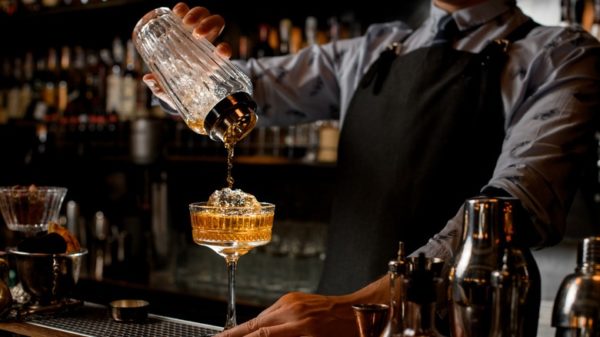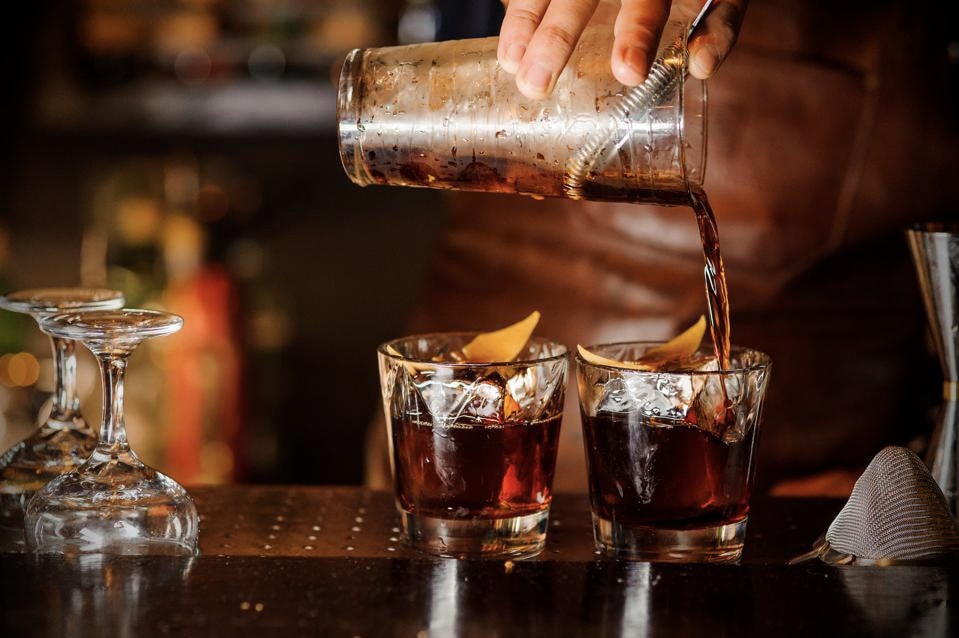“Which side of the bar are you working: service or personality?” A bartender friend told me he and his cohorts would ask each other this question before every shift, referring to the difference between working the service end of the bar or the main stage. In busy cocktail lounges, upscale restaurants, and high-volume bars, at least two bartenders are usually slinging drinks at a time. One is assigned to serve guests seated at the counter where chitter-chatter is an expected garnish (the personality), and the other is responsible for churning out cocktails for hungry guests in the dining room, typically from a tiny crevice at the end of the bar. Most of the time when you order a drink at a table in a restaurant with a decent cocktail menu, it’s made by the service bartender.
The service bar is one of the most congested and chaotic areas of any bar or restaurant, even when it’s well-organized and functioning smoothly. Servers crowd the area anxiously awaiting their drinks like brain-eating zombies. In sit-down restaurants, most diners expect to be served their first drink before they consider the menu, which means that any delays in the arrival of their drinks are a clusterfuck. Responsibility for making those drinks, sometimes including orders for large parties, falls on one individual — not only to make delicious cocktails, but also to make them quickly. When tables need to be turned for the next seating, a service bartender’s failure to keep up can be as destructive as a kitchen meltdown.
“Working service,” as many bartenders call it, is a thankless job. “It’s the most vital position that nobody wants to work,” says Jabriel Donohue, who’s tended bar in Seattle for years and now co-owns a hospitality group based in northwest Washington. “The service bartender helps maintain the illusion that the main bartenders can effortlessly put a drink in everyone’s hand,” Donohue adds. (He recently wrote an essay about dive bars for our site.)
Making drinks is only half the battle. Service bartenders spend the night yelling for someone to bring more ice. Glassware is always running low, and the ones coming straight out of the dishwasher are too hot to use. The barback is AWOL, probably in the employee bathroom checking his phone again. Some drunk douchebag is standing in the pass blocking the area where the waiters pick up their drinks, waving a twenty around like he’s in a strip club. Service bartenders can’t afford distraction, or they’ll fall behind and get buried.

Despite how important the service bar is to a restaurant’s flow, however, the service bartender often plays second fiddle to the front bartender. You won’t see anyone throwing martinis or flaming orange peels on the service end of the bar. Working service requires building three or four drinks at a time, two-handed stirring and shaking, and learning to juggle incoming tickets with the dexterity of a short order cook. “Working service is where the cracks in your technique or sometimes just your conditioning are most likely to show,” Donohue, who’s worked as a bartender in the Seattle area for years, says. Many of the world’s finest mixologists collapse behind the service bar because service bartending works a totally different set of muscle groups.
Some bartenders prefer the chaotic zen of working service because it spares them having to interact with guests. Others hate it because it can be a relentless and stressful shift. Assignment to the service end of the bar is sometimes treated as punishment for tardiness or poor performance. Many bars also have an unspoken hierarchy or pecking order where rookies—or the least experienced team members—are assigned to work service while seasoned veterans commandeer the front bar.
There’s no glamor or glory working service, but a well-executed service bar keeps the trains running on time and makes a robust cocktail program possible in a large restaurant space. On any given night, the service bartender might make up to 5-10 times as many drinks that come from the front bar, sometimes more in high-volume restaurants.
Donohue believes that competency behind the service bar may be the truest test of a bartender’s skill. He thinks bartenders should hone their craft working service before being called up to the big show. “The service bar should the second to last step on the way to working the main bar,” he says, “because every bartender’s hands need to be able to move at least as fast as their mouths.” You won’t see these types of skills tested on Drink Masters because service bartending isn’t sexy. But Donohue insists that having someone skilled behind the service bar is vital to a restaurant’s successful operation. “It’s just you and the ticket printer and god help you if you fall behind or even worse, get sloppy and start putting out substandard drinks,” he says. “There’s no way to fake it in the service well. You either make it or you don’t.”

